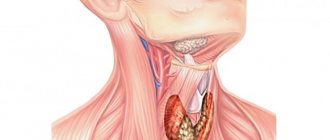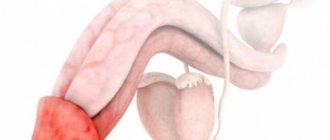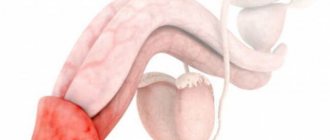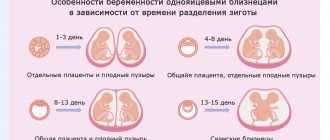Astheno-neurotic syndrome in children is a common pathology of the nervous system, which occurs as a result of overwork and severe emotional shock. With neurasthenia, children look healthy, but tired.
Symptoms of astheno-neurotic syndrome in children are similar to the clinical manifestations of depression, vegetative-vascular dystonia, and chronic fatigue.
People who are far from medicine do not know what astheno-neurotic syndrome in children is and how to treat this disease. It is often difficult for parents to suspect a nervous system disorder in their child, since they attribute moodiness, fatigue, and tearfulness to the child’s character traits. As a result, instead of helping a child suffering from a neurotic disorder, parents scold and punish him, aggravating the situation.
GENERAL INFORMATION ABOUT PATHOLOGY
Neurasthenia in children is a symptom complex that occurs as a result of exhaustion of the nervous system. The symptoms of neurasthenia in children differ from the signs of neurasthenia in adults.
Doctors call this disease irritable fatigue syndrome. Asthenoneurosis occurs not only in children, but also in adolescents. This disorder is one of the common causes of a decrease in a child’s school performance and conflict in relationships with peers and adults.
Asthenoneurosis can be a consequence of intrauterine pathology of the development of the nervous system, birth trauma, or an infection suffered by the baby in the early postnatal period. In this case, signs of the disease appear at 2–3 years. The disease can also develop at school age as a result of excessive stress on the nervous system.
Symptoms and signs of neurasthenia in children should be a reason to visit a doctor. Without timely treatment, they will lead to irreversible changes in the child’s psyche.
Consequences
Astheno-neurotic syndrome can have the most negative consequences.
A person can be plagued by panic attacks, which have a wide variety of colors - from an attack of “everything is lost” to a panicky fear of death.
The attacks are temporary and begin and end unexpectedly. At this time, tachycardia, a state of mental agitation or lethargy is observed.
Among the physical manifestations during an attack are possible upset stools and excessive urination.
Read more about panic attacks in our articles. What can trigger a panic attack: symptoms and signs of a panic attack
According to statistics, symptoms of a panic attack occur in 45–70% of the world's population, which is an impressive figure. And often the first...
How to get rid of panic attacks forever - treatment with hypnosis, pills, homeopathy and folk remedies
Sudden panic attacks can greatly complicate the lives of their victims. Many people develop depression as a result of such conditions...
SYMPTOMS OF THE DISEASE
Symptoms of the disease are associated with disturbances in the functioning of the nervous system. Clinical psychologists and psychiatrists classify the signs of the disease into 2 groups:
- Symptoms caused by disturbances in the functioning of the autonomic nervous system. Symptoms of this group include all physiological manifestations of neurasthenia: increased sweating, physiological dependence on sweets, enuresis, heart rate deviation from the average age norm, decreased blood pressure, decreased immunity to colds.
- Symptoms caused by disturbances in brain function. This group of symptoms includes behavioral manifestations of neurasthenia: causeless mood swings, inadequate reactions to the words and actions of others, poor control of emotional manifestations, sleep disturbances, a predominance of low mood, depression, decreased voluntary memory and concentration, motor disinhibition, and the appearance of various phobias.
SYMPTOMS IN CHILDREN 2–6 YEARS OLD
Astheno-neurotic syndrome in preschool children manifests itself in the form of:
- fearfulness, phobias, excessive impressionability;
- logoneurosis in the form of rapid speech and unclear sound pronunciation
- tearfulness, moodiness;
- irritability and short temper;
- unmotivated aggression towards peers, self-aggression;
- abuse of toys;
- tendency to tear, break, spoil things, books;
- restlessness and fussiness, motor disinhibition, obsessive movements;
- depressed mood;
- convulsive syndrome and nervous tics;
- restless sleep;
- loss of interest in favorite games, lethargy;
- psychosomatic manifestations (pain in the neck and arms, constipation).
SYMPTOMS IN SCHOOLCHILDREN
Symptoms of astheno-neurotic syndrome in school-age children are:
- irritability and nervous excitability;
- vulnerability, touchiness;
- isolation;
- fatigue, decreased performance;
- increased situational and personal anxiety and causeless worry;
- mood swings;
- panic attacks and phobias;
- decreased concentration of voluntary attention;
- a sharp decline in academic performance;
- headache;
- sleep problems;
- appetite disorder;
- Vivid emotional outbursts in the form of screaming, falling to the floor, hysterics.
Forecast
Asthenoneurosis is not a serious disease if treated promptly. People with asthenia need to be registered with a neurologist, follow all his recommendations and take the necessary medications. A healthy active lifestyle, good mood and a positive outlook on the world also play a decisive role in the treatment of the syndrome. The main thing is not to start the course of the disease, which can lead to memory deterioration, decreased concentration and the development of depression or neurasthenia.
STAGES OF ASTHEN-NEUROTIC SYNDROME
The following stages are distinguished in the development of a neurotic disorder:
- Hypertensive neurasthenia. At this stage, the patient experiences increased excitability and irritability, emotional sensitivity, decreased efficiency in performing mental or physical labor, absent-mindedness, girdling headache, and sleep problems.
- Irritable weakness. The disease moves to the second stage if the patient ignored the initial signs of the disease and did not seek medical help. This stage is characterized by the fact that a person can no longer hide his irritability, his nervous system is quickly depleted. The patient cannot concentrate on the production or educational tasks facing him due to constant headaches and weakness in the body. A person feels overwhelmed in the morning.
- Hyposthenic neurasthenia. If you do not see a doctor at the second stage, the disease develops into stage 3. The patient develops chronic fatigue, sad mood, apathy, and drowsiness. Psychosomatic disorders appear: skin itching, hair loss, brittle nails, pain in the spine and joints, decreased hearing and visual acuity, exacerbation of chronic diseases.
Prevention of the syndrome
To prevent the disease, the same drugs that are necessary to treat the syndrome are suitable. Experts advise introducing a daily routine, most of which should be rest. You should switch to a healthy diet filled with vitamins and beneficial microelements. In this case, it is necessary to limit the consumption of fats and carbohydrates. Physical exercise and walks in the fresh air will also help distract from the symptoms of “chronic fatigue” and improve a person’s overall well-being.
VARIETIES OF SYNDROME
Experts have come to the conclusion that astheno-neurotic syndrome in children is a disease that can be found in such forms as:
- Cerebrasthenic asthenoneurosis is a congenital pathology caused by organic lesions of the brain.
- Residual asthenia is a congenital type of neurosis that occurs as a result of pathology of the nervous system or as a result of a birth injury to the head. Manifestations of this type of disease are tearfulness, enuresis, and impaired fine and gross motor skills.
- Somatogenic asthenia is a type of psychosomatic illness. As a rule, this type of neurosis develops in children with a history of disturbances in the functioning of the digestive system in the form of gastritis and ulcerative lesions of the duodenum.
- Dysontogenetic asthenia, the main symptoms of which are chronic fatigue, low performance and poor concentration on an intellectual task.
- Psychosocial neurasthenia is a neurosis that arises as a consequence of an unfavorable situation in the family. In adolescence, this form of asthenia can develop as a result of the child’s rejection by his peers. This type of disease is manifested by insomnia and frequent headaches.
- Hyperdynamic asthenia is a form of neurotic disorder in preschool children. It manifests itself in the form of motor disinhibition, restlessness, and fussiness of the child.
- Hypodynamic asthenia is a type of neurosis in which the processes of inhibition in the nervous system prevail over the processes of excitation. The child is passive, inactive, immersed in his own inner world, avoids communication with peers and active games. The main cause of this type of disease is underweight or overweight, weak muscle tone, and a tendency to catch colds.
Do I have asthenia?
- Signs of asthenia, is it a disease?
- Can asthenia be a normal variant?
- Is this a temporary and reversible condition?
- If there are signs of asthenia, do you need medical help?
- Is it possible to avoid the disease?
- What symptoms are included in this category?
The answers to these questions have been prepared for you by our doctors. Let's start with how this condition manifests itself.
Primary signs of asthenia
- Fatigue, weakness
- Irritability, feeling dissatisfied with others
- Decreased health
- Various sexual disorders, breakdowns, etc.
- Exhausted attention with excessive specificity
- Tearfulness, increased sentimentality.
- Sleep disorders (insomnia at night, drowsiness during the day).
- Poor tolerance to loud sounds, bright lights, strong odors.
- Headache.
- Nervousness.
- Feeling of inner trembling.
- Poor appetite.
- Excessive worry about unimportant reasons.
- Difficulty in making decisions.
- Thoughts are easily lost and it is difficult to concentrate.
- Autonomic symptoms: palpitations, sweating, shortness of breath, trembling, trembling sensation.
- Unpleasant sensations in different parts of the body that can change and “migrate”.
Course of asthenia
The course of astheno-neurotic syndrome or asthenia is often associated with possible complications that accumulate and develop due to the duration of this pathological process. Therefore, doctors strongly recommend not to delay treatment of asthenia or treatment of astheno-neurotic syndrome. An exhausted nervous system is easily susceptible to the formation of a wide variety of pathologies of the mental spectrum of diseases.
Despite the fact that the prognosis for the treatment of asthenia or treatment of astheno-neurotic syndrome in the vast majority of cases has a favorable prognosis, the duration of therapy can be quite long and depends on both the depth of the disorder and the duration of its course.
Asthenia can occur in the form of attacks, with complete recovery during periods of calm. However, more often the asthenic state is characterized by a constant (often with intensification in the evening), “as a background” and long-term course.
CAUSES OF NERVOUS DISORDER
Asthenia can occur for the following reasons:
- genetic predisposition to nervous system disorders;
- melancholic or choleric type of temperament in a child;
- self-doubt, low self-esteem;
- asphyxia during childbirth or oxygen starvation of the fetus during intrauterine development;
- severe emotional distress of the mother during pregnancy;
- pronounced toxicosis during gestation;
- exposure of the fetus to toxic substances as a result of maternal use of medications, alcohol, or smoking during pregnancy;
- Rh conflict between mother and child;
- disruption of metabolic processes in the cerebral cortex as a result of neuronal pathologies and diseases of the meninges;
- cerebral palsy;
- spinal injuries;
- weakened immunity of the child;
- traumatic brain injury or infectious diseases during early childhood;
- increased intracranial pressure;
- meningitis, arachnoiditis and encephalitis;
- brain oncology;
- abnormalities in the functioning of the kidneys and liver;
- deficiency of B vitamins in the body;
- hormonal imbalance, pathology of the endocrine system;
- thyroid dysfunction;
- diabetes;
- prolonged exposure to stress or severe emotional shock;
- unfavorable psychological atmosphere in the family, conflicts in relationships with loved ones;
- excessive severity of parents, use of cruel methods of education against a child;
- low socio-psychological status of the child in the group of peers;
- difficulties in socializing and adapting a child to a new team and place of residence;
- physical fatigue caused by violation of the work and rest regime;
- excessive number of activities for children in the field of additional education;
- teenage gambling addiction;
- uncontrolled viewing by children of television programs and films that have a negative impact on the psyche;
- adolescent use of psychotropic substances, alcohol, drugs.
Who can help with neurosis?
If you can’t cope with a depressed state on your own, it’s better to consult a specialist. Taking sedatives, and especially antidepressants, without medical supervision can only aggravate the condition and cause addiction, and most importantly, the medications do not solve the main problem that caused the disease.
Depressive, asthenic and anxiety-neurotic conditions can be stopped completely after a course of psychotherapy, during which you will work with a doctor on a traumatic situation, change negative attitudes, and competent prescription of medicinal support, relaxation, art therapy and restorative procedures will help consolidate the result.
The doctors of our Center know how to help a person suffering from neurosis with one or another component. An individual approach to psychotherapy and selection of medications, a friendly atmosphere and comprehensive treatment will help break the vicious circle of traumatic events and find a new life - calm, confident, joyful.
DIAGNOSTICS
Diagnosis of asthenoneurosis is carried out using methods such as:
- Interviewing the patient, collecting anamnesis. Identification of factors that provoked the disease. Comparison of data from a psychiatrist, neurologist and therapist.
- Diagnosis of the condition of the patient’s internal organs using EEG, ECG, computer technology, radiography and ultrasound. Assessing the patient's reaction to bright light and various sounds. Assessment of the safety of reflex activity. Correlation of the current state of mental development of the patient with the average indicators of the age norm.
- Laboratory diagnostics. A general blood test and biochemical examination of a blood sample can exclude the presence of various infectious, immunological, and hematological diseases in the patient.
- Psychological diagnostics. Assessment of the level of voluntary attention, memory, identification of features of logical thinking. As a rule, in patients with asthenoneurosis, signs of fatigue appear after 10–15 minutes of examination.
The final diagnosis is made based on a comprehensive analysis of information about the patient and clinical symptoms. In some cases, consultation with related specialists is required to determine the patient’s neurological status.
Causes
Neurasthenia develops in people against the background of mental and physical overload, which, in turn, provokes overwork of the body. The reason for the development of this condition can be internal conflicts, a weak psyche, long-term adherence to a very strict diet, etc.
The occurrence of neurasthenia is influenced by predisposing and provoking factors. Predisposing ones include:
- increased anxiety;
- tendency towards perfectionism;
- period of recovery after somatic illnesses.
Provoking include :
- severe stress;
- conflict situations in the family and at work;
- lack of normal rest for a long time;
- previous traumas, including birth injuries;
- previous surgical interventions;
- infectious diseases;
- poor nutrition and, as a result, deficiency of vitamins and other important substances;
- alcohol abuse, smoking;
- lack of physical activity;
- lack of sleep;
- intoxication;
- endocrinological disorders;
- unfavorable psychosocial conditions;
- severe weather conditions, etc.
TREATMENT OF ASTHEN-NEUROTIC SYNDROME
An integrated approach is effective in treating neurasthenia. The patient is prescribed a course of drug therapy, psychocorrective and psychotherapeutic sessions.
The main medications for the treatment of neurasthenia are tranquilizers, nootropics, sedatives, drugs to normalize blood circulation, amino acids, and antidepressants. In particularly severe cases, the patient is hospitalized.
UHF, balneotherapy, restorative massage, and light therapy have a positive effect on the nervous system.
From the age of 4, children are prescribed psychotherapy to treat various forms of asthenia. During the classes, the psychotherapist teaches the child to understand and control his emotions, to express his emotional experiences in a socially acceptable way. At the same time, psychological correction is carried out aimed at correcting negative character traits, overcoming fears, and normalizing the psycho-emotional state. Art therapeutic techniques help a child to know and accept himself, and find personal resources. All this facilitates the child’s socialization process.
The conditions for a speedy recovery are:
- the child's adherence to the daily routine;
- systematic exercise, performing a set of morning exercises;
- rational nutrition and use of vitamin and mineral complexes recommended by a doctor;
- daily walks lasting 1–2 hours;
- creation of a favorable psychological atmosphere in the family, attentive and respectful attitude towards the child on the part of parents.
In addition to working with the child, consultation with a psychologist is necessary for parents of a neurasthenic person. In the process of psychological counseling, the specialist teaches parents constructive intra-family interaction, forms in parents a stock of effective coping strategies and teaches methods of conflict-free communication.
Treatment of asthenoneurosis
Therapy for the syndrome should be comprehensive and include several areas:
- Taking medications. Usually, during the first stage of development of the syndrome, one can limit oneself to the use of herbal tea, vitamin complexes and the use of traditional medicine. If a person’s health worsens, the doctor prescribes various sedatives, and sometimes antidepressants.
- Psychological help. In the early stages, the disease can be cured even at home: aromatherapy, relaxing baths and walks in the fresh air.
- Healthy lifestyle. Proper nutrition, exercise and a clear daily routine will help cope with any disease, including asthenoneurosis.
Drug treatment
Drug therapy involves taking the following drugs:
- Sedatives: “Sedasen”, “Persen”, as well as tinctures of motherwort, hawthorn and valerian. The course of treatment must be at least two weeks.
- Antidepressants with the least number of side effects: Novo-Passit, Azafen, Doxepin, Sertraline.
- Antiasthenic agents: Enerion and Adamantylphenylamine.
- Nootropics: “Phenibut”, “Cortexin”, “Nooclerin”.
- Adaptogens: “Chinese lemongrass”, “Eleutherococcus tincture”.
- Vitamin complexes: “Neuromultivit”.
Physiotherapeutic procedures are also usually prescribed along with drug treatment: therapeutic massage, aromatherapy, electrosleep and reflexology.
Psychotherapy
Therapy for asthenic syndrome is impossible to imagine without the help of a psychologist. The patient should definitely visit a specialist to clarify the diagnosis and prescribe appropriate treatment.
Typically, a psychotherapist advises a patient to take a break from his own illness and take up a hobby, for example, collecting coins, crocheting or painting. Also, art therapy or sand therapy has been helping patients cope with asthenoneurosis for many years. You should not neglect breathing exercises, as it helps not only to relax the whole body, but also to recharge yourself in a good mood.
The following recommendations will help you cope with the disease:
- First of all, you need to get rid of all bad habits;
- You should do strength exercises and expose your body to cardio exercises every day;
- Work should always be alternated with rest; you should not overexert yourself;
- It is worth adding more meat, soy, beans and bananas to your usual diet;
- It is mandatory to take vitamin complexes;
- And the most important thing is to maintain a great mood throughout the day.
Traditional therapy
First of all, we should not forget that treating asthenia only with traditional methods is extremely undesirable, since a positive effect can only be obtained with complex therapy. But as an additional effect, doctors recommend the following recipes:
Mint leaves, trefoil roots and valerian in equal proportions, approximately 2 tbsp. l., you need to finely chop and mix. Afterwards, add 2 tsp to a glass of boiling water. collect, leave for an hour in a warm place, then strain. Every day you should drink half a glass in the morning and evening. The course of treatment is a month.- 2 tbsp. l. motherwort should be poured with a glass of boiling water and placed in a water bath for 20-30 minutes, without bringing to a boil. Then you should add boiled water to the volume that was in the bowl at first. Take the decoction 3 times a day before meals, 1⁄3 of a glass.
- Valerian and motherwort can also be taken in tablet form. The attending physician must determine the required dosage. To prepare an infusion of valerian officinalis, add a tablespoon of the herb to hot boiled water and leave for 20 minutes. Take a quarter of a glass three times a day and before bedtime.
- Chamomile, St. John's wort and hawthorn must be mixed 1 tbsp. l. and pour a glass of boiling water. The infusion should stand for 30-40 minutes. It is recommended to take the medicine before going to bed.
- Combining St. John's wort with dried linden blossom will also help cope with chronic fatigue. You need to mix 1 tbsp. l. components and leave the infusion for 20 minutes. The drink should be taken on an empty stomach in the morning and in the evening before bed, 50 ml. Sometimes an alcohol tincture is prepared from herbs, which must be taken 2-3 drops before meals.
- To improve your mood and stimulate the nervous system, you can take a course of treatment with Schisandra chinensis or Eleutherococcus, which are sold at any pharmacy. The products have a beneficial effect on the entire body, help boost immunity, recharge with energy and a positive mood. Tinctures will also help cope with apathy, hysteria, hypotension and headaches due to asthenic syndrome.
Diet for neuro-asthenic syndrome
It is necessary to exclude fatty meat, any fried foods and hot seasonings from the patient’s usual diet. You should limit your consumption of coffee and tea; you can replace them with infusion of hawthorn or rose hips. It is recommended to eat as many fruits and vegetables as possible. Vegetable oil, black bread and fatty fish will also help improve your well-being. And in order to cheer up, experts recommend eating a slice of dark chocolate a day and under no circumstances consuming baked goods.
Treatment of the syndrome in children
Treatment of asthenic syndrome in children is slightly different from treatment of the disease in adults. To help your child you should:
- Introduce into his diet as much as possible the right healthy food, useful with vitamins and various microelements;
- Eliminate drinks that contain caffeine from your diet;
- Ventilate the baby’s room several times a day;
- In the evening you need to spend time in the fresh air, it is especially useful to walk just before bed;
- Ensure full, healthy sleep both during the day and at night;
- Avoid watching TV and playing on the computer during an exacerbation of the disease.
COMPLICATIONS OF THE DISEASE
Common complications of astheno-neurotic disorder are:
- hormonal disorders that increase the risk of pathology of the digestive tract, acceleration or slowdown of puberty;
- lack of reproductive capacity in adult life;
- socialization difficulties;
- depression, suicidal thoughts;
If you start treatment for a neurotic disorder at the initial stage, negative consequences and complications can be avoided.
Symptoms and signs of neurasthenia
Signs and symptoms of astheno-neurotic syndrome depend on the stage of the disease.
- At the first stage, the symptoms of neurasthenic syndrome are: irritability, unstable emotions, severe excitability, aggressiveness, tearfulness. Women often have a tendency to become hysterical and experience mood swings.
- At the second stage, symptoms of neurasthenia in adults and children are manifested by a general loss of strength, fatigue, and weakness. immunity deteriorates , which can lead to somatic diseases.
- The third stage is characterized by depression. The patient wants peace and loneliness, he exhibits apathy and lethargy, and lacks joy in life.
In general, the symptoms of neurasthenia can be very diverse. The most typical of them are characterized by a weakening of the functions of internal inhibition.
- Irritability – lack of restraint is manifested, which was previously uncharacteristic. Even minor reasons can lead to the patient reacting violently to them with shouts and actions.
- Sensitivity to minor irritants - for example, the patient can be very irritated by the rustling of paper, the sound of operating equipment, etc.
- Frequent emotional outbursts – characterized by frequent but short manifestations of rage. During such attacks, consciousness is preserved.
- Tearfulness is increased excitability, which was previously unusual for humans.
- Absent-mindedness and memory impairment - concentration of attention becomes more difficult, so the patient tries to avoid mental effort.
- Problems of a sexual nature – in men, premature ejaculation is possible, and this can subsequently develop into an obsessive syndrome. It is difficult for women to find pleasure during sexual intercourse because they cannot distract themselves from obsessive thoughts. If the problem worsens, it can lead to frigidity in women and weakened potency in men.
- Increased sensitivity - irritating sound, light, increased sensitivity to heat and cold.
- Insomnia – due to thinking about problems, the patient cannot fall asleep at night. This ultimately leads to fear that he will never be able to fall asleep, which ultimately makes the situation worse.
- Feeling of morning exhaustion - the patient wakes up in a bad mood, he does not want to get out of bed. However, in the evening he feels a little more alert, which prevents him from going to bed on time and fully resting.
- Constant fatigue, both physical and mental. A feeling of emptiness is typical - nothing pleases the patient, everything seems gray and faceless.
- Headaches - characterized by a girdling pain, as if a helmet was put on the head.
- Somatic manifestations - the back and muscles may ache, sweating appears, problems with the gastrointestinal tract, frequent urination, etc.
If timely and adequate treatment is not provided, neurasthenia can lead to diseases of both a neurological and physiological nature.
MY RECOMMENDATIONS
Children facing neurotic disorders need sessions with a psychologist. The duration of the course is 3–6 months. This is necessary to develop adequate self-esteem in children and prevent relapse of the disease.
Children with asthenia need to be taught the rules of interpersonal interaction and group work. Therefore, during psychological rehabilitation, both individual classes and group trainings are conducted.
Art therapy classes help children find hobbies. Having gained the opportunity for self-realization, children find something to do - creativity has a healing effect on them.
You can strengthen family relationships and normalize the psychological climate at home through joint leisure time between children and parents, visiting the theater and cinema. However, when organizing meaningful leisure time, you should remember that an excess of vivid impressions is also a load on the nervous system, which may be too much for an exhausted body.
Disease prevention
In the event of the appearance of asthenic disorders caused by psychogenic stress and social factors, it is necessary to take preventive measures that will minimize the risk of resumption or appearance of asthenia.
These include:
- change of place of work;
- change of environment;
- complete rest;
- quality sleep at a certain time;
- accessible physical exercise;
- relaxing massage;
- swimming;
- reflexology;
- meditative techniques.
What else can you do?
In the modern social environment, stress and physical strain cannot be avoided. But it is necessary to strive to reduce the influence of psychogenic stress on the body. If you are overextended at work, change it.
If you have a conflicting relationship with your boss, find a new job. If you strive to achieve career heights, engage in auto-training or Eastern techniques
(wu-shu, kung fu, qigong).
Set aside special time for sports, swimming, fitness, yoga. Take time for walks in nature. Get a pet - spending time with pets relieves stress!
Aquarium fish are simply a wonderful way to calm down. A domestic cat of the Russian breed purrs mesmerizingly. A little playful lap dog - and the stress is relieved!
Don't go into deep depression over the loss of a loved one. Life is fleeting!
Many people find it helpful to attend church and attend services.
Make it a rule to attend church services on Sundays and holidays. The Church heals the soul, which means that the nerves will be in order.
Do some handicrafts
, various crafts. Find yourself a hobby and devote part of your time to your favorite activity.
Finally love yourself. Your happiness should not depend on the whims of fate and other people. Be healthy!
Consequences and complications
With a prolonged course of the disease, nervous processes are depleted, which leads to the development of a number of diseases. Often patients with neurasthenia complain of insomnia , chronic headaches and intestinal manifestations. They may develop eating disorders ( anorexia , bulimia , etc.). Possible phobias, obsessive thoughts, paresthesia . In women, libido may decrease, and in men, potency may decrease.
With neurasthenia, it is difficult for a person to maintain social connections. Over time, psychological problems worsen and against this background, severe mental illness can develop.
Tests and diagnostics
The specialist carries out diagnostics, assessing the clinical picture, as well as the complaints of the patient and his loved ones. In the process of establishing a diagnosis, it is imperative to visit a therapist and carry out the examinations that he prescribes in order to exclude other diseases.
Since neurasthenia can be a sign of brain diseases. Therefore, it is important to conduct a CT scan or magnetic resonance imaging to rule out such diseases. The doctor may also prescribe rheoencephalography to assess blood circulation in the brain.
You can take a test for neurasthenia on a variety of online resources. However, such a test cannot be considered an analogue of diagnosis - it can only be used to confirm or refute the presence of a predisposition to such a disease.










